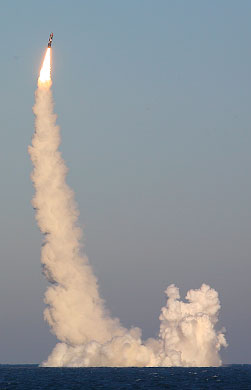RSM-56 Bulava facts for kids
Quick facts for kids RSM-56 Bulava |
|
|---|---|

Bulava launched from submarine Yuri Dolgoruky on 28 October 2011
|
|
| Type | SLBM |
| Place of origin | Russia |
| Service history | |
| In service | 2018–present |
| Used by | Russian Navy |
| Production history | |
| Designer | Moscow Institute of Thermal Technology |
| Manufacturer | Votkinsk Plant State Production Association |
| Unit cost | $32.2 million (2012) |
| Produced | 2011 |
| Specifications | |
| Mass | 36.8 t (36.2 long tons; 40.6 short tons) |
| Length | 11.5 m (38 ft) (without warhead) 12.1 m (40 ft) (launch container) |
| Diameter | 2 m (6 ft 7 in) (missile) 2.1 m (6 ft 11 in) (launch container) |
| Warhead | 6-10 × 100-150 kt MIRVs |
|
|
|
| Engine | Three stage solid and liquid head stage |
| Payload capacity | 1150 kg |
| Propellant | Solid propellant and liquid fuel |
|
Operational
range |
8,300 km ≥ 9,300, 15,000km |
|
Guidance
system |
Inertial guidance, possibly with Astro-inertial guidance and/or GLONASS update |
| Accuracy | classified |
|
Launch
platform |
Borei-class submarines Typhoon-class submarine Dmitri Donskoi (as a testbed) |
The RSM-56 Bulava is a powerful submarine-launched ballistic missile (SLBM) made for the Russian Navy. It was first used in 2019. This missile is carried by the new Borei class class of nuclear submarines.
The Bulava missile is a very important part of Russia's nuclear triad. This means it's one of three main ways Russia can deliver nuclear weapons: from land, air, or sea. The word "Bulava" (Булава) is Russian for "mace", which is a type of heavy club.
The Moscow Institute of Thermal Technology designed this missile. Work on it began in the late 1990s. It was created to replace an older missile called the R-39 Rif. Each Project 955/955A Borei-class submarine can carry 16 of these missiles.
In 2018, the Bulava missile system was officially accepted for use by the Russian Navy. This happened after successful tests, including one where four missiles were launched at once.
Contents
What is the Bulava Missile?
The Bulava missile was developed by the Moscow Institute of Thermal Technology. The main designer was Yury Solomonov. Even though it uses some ideas from the RT-2PM2 Topol-M ICBM (an intercontinental ballistic missile), the Bulava is mostly a brand new design.
The Bulava is like a submarine version of the Topol-M. It is lighter and thinner than some other missiles. Both missiles can travel similar distances and have similar accuracy. The Bulava can carry a payload of 1,150 kilograms up to 9,500 kilometers.
How the Bulava Missile Works
The missile has three parts, called stages.
- The first two stages use solid fuel to push the missile.
- The third stage uses liquid fuel. This allows the missile to move very well when its warheads are separating.
The Bulava can be launched even when the submarine is moving at an angle. It flies at a low height, which means it can be called a "quasi-ballistic missile." This type of missile flies on a flatter path than a typical ballistic missile. It is also thought to have special ways to avoid missile defense systems. It can even change direction during its early flight.
Role in Nuclear Defense
The Borei-class submarines, which carry Bulava missiles, are expected to be a key part of Russia's nuclear defense until at least 2040. This shows how important the Bulava missile is for Russia's military plans.
The Bulava missile can also be loaded onto other types of launchers. These include mobile launchers that travel on roads or special railway trains.
Bulava Missile Specifications
Here's how the Bulava missile compares to some other similar missiles:
| Bulava R-30 | Trident C4 | Trident D5 | M51 (missile) | JL-2 | |
|---|---|---|---|---|---|
| Number of stages | 3 | 3 | 3 | 3 | 3 |
| Length of assembled missile without front section, m | 11.5 | 10.3 | 13.59 | 12 | 13 |
| Maximum diameter of missile airframe (without stabilizers, raceways, protruding elements), m | 2 | 1.88 | 2.11 | 2.3 | 2 |
| Launch weight, tonnes | 36.8 | 32.3 | 58.5 | 52 | 42 |
| Total length of missile as a unit with launch canister (with front section), m | 12.1 | n/a | 13.58 | n/a | n/a |
| Throw weight, kg | 1,150 | 1,500 | 2,800 | n/a | n/a |
| Throw Weight (kg) Per Tonne | 31.25 | 46.44 | 47.86 | n/a | n/a |
| Warhead | 6-10 × 100-150 kt | 8 × 100 kt | 8 × 475 kt (Mk-5 RV); 14 × 90-100 kt (Mk-4/Mk-4A); ≥1 × 5-7 kt (W76-2) |
6-10 × 100-300 kt | 1 × 1 Mt |
| Operational range, km | 8,000-15,000 | 7,400 | 6,700-12,000 | 8,000-10,000 | 7,200 |
| Accuracy, CEP (meters) | 350 | 229-500 | 100-381 (Mk-4 RV, to be retired) | 150-200 | n/a |
| Navigation | astro-inertial, GLONASS | astro-inertial | astro-inertial, GPS | astro-inertial, Galileo | astro-inertial, BeiDou |
| In service | 2018–present | 1979 - 2005 | 1990–present | 2010–present | 2015–present |
See also
 In Spanish: R-30 Bulava para niños
In Spanish: R-30 Bulava para niños


